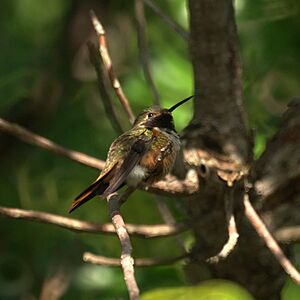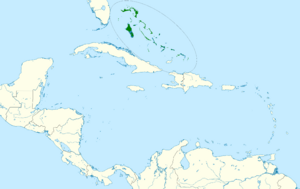Bahama woodstar facts for kids
Quick facts for kids Bahama woodstar |
|
|---|---|
 |
|
| Conservation status | |
| Scientific classification | |
| Genus: |
Nesophlox
|
| Species: |
evelynae
|
 |
|
| Synonyms | |
|
|
The Bahama woodstar or Bahama hummingbird (Nesophlox evelynae) is a tiny bird. It is a type of hummingbird found only in the Lucayan archipelago. This includes the Bahamas and Turks and Caicos islands. Locals call it the "hummer" because of the distinct humming sound it makes while it eats.
Contents
What is the Bahama Woodstar?
Hummingbirds are a very large group of birds. There are about 338 different kinds! Scientists are always studying these birds. They want to understand how different hummingbird groups are related. The Bahama woodstar belongs to a group called the "bee clade." This is the youngest and fastest-growing group of hummingbirds. A cool fact about this group is that the male birds use their tails to make sounds!
Scientists recently looked closer at the Bahama woodstar. It used to have two types: the Bahama woodstar and the Inagua woodstar. But now, the Inagua woodstar is its own species (Nesophlox lyrura). This is because hummingbirds can be told apart by their tail shapes. Also, they can be different by whether they have shiny, colorful feathers. These features are important for attracting a mate. The Inagua woodstar has a very shiny head and a tail shaped like a lyre (a small harp). The Bahama woodstar's tail is different.
This bird was once in a group called Calliphlox. But in 2014, scientists studied their genes. They found that the Calliphlox group was not made up of closely related birds. So, the Bahama woodstar was moved to an older group called Nesophlox. This helps keep bird families organized correctly.
What Does It Look Like?
The Bahama woodstar is a very small hummingbird. It grows to be only about 8 to 9.5 cm (3.1 to 3.7 in) long. These birds weigh around 2.4 to 3 g (0.085 to 0.106 oz). Their backs are green and gold. Their bellies are a light olive color. The sides of their bodies fade into white for males and cinnamon for females. Their wings are brown, and their tails look blackish-purple.
Male Bahama woodstars have a fork-shaped tail. Females have a more rounded tail with wider feathers. Males also have bright purple, shiny throat feathers. These are called gorgets. They have a white stripe below them. These bright colors become duller after the breeding season. Females do not have the purple throat or white stripe. Both male and female birds have black bills that are slightly curved. They also have black feet.
Sounds They Make
The Bahama woodstar makes three main sounds: "chips," scolding, and a song. When they are flying or eating, they make a one-syllable "chip" sound. This sound can be short or a longer, repeated series of "chips." Males also make short "spurts" when they are trying to attract a mate or fighting. Young birds sometimes make "cheep" sounds.
They make a "scolding" sound when they are fighting or chasing other birds. This sound has two syllables. The second syllable might be repeated many times. The "chip" and scolding sounds are high-pitched.
Males sing when they are resting on a branch or trying to attract females. Their song is high-pitched and lasts about 30 seconds. The Bahama woodstar's call sounds a bit like the Anna's hummingbird from North America.
Where Do They Live?
The Bahama woodstar lives across the Lucayan Archipelago. This includes the Turks and Caicos Islands. However, they are not found on the Inaguan islands. They have also been seen a few times in Florida, United States. In April 2013, one was seen for three days in Pennsylvania.
They are less common on the Grand Bahama, Abaco, and Andros Islands. This is because of the Cuban emerald, another hummingbird that has moved into these areas. The Cuban emerald can be aggressive towards the Bahama woodstar.
Bahama woodstars live in many different places. You can find them in gardens, scrubland, and the edges of tropical evergreen forests and pine forests. They usually stay in these areas all year round. Even though they might live near other woodstars, they are not very social. They often act aggressively towards other birds.
How They Live
What Do They Eat?
Bahama woodstars mostly drink nectar from local flowers. On the Abaco Islands, they often visit a plant called Ernodea serratifolia. They visit these flowers in the mornings and evenings. You can sometimes see small cuts in the flowers where the birds' beaks took the nectar. They also eat insects.
Raising a Family
The main breeding season for Bahama woodstars is in April. However, they can breed throughout the year. During this time, male birds try to attract females with special flying displays. These are called shuttle displays and aerial dives.
Shuttle displays have three forms: initial, typical, and alternate.
- The initial shuttle is a short period of flying side to side. Then, the male hovers over the female.
- Typical shuttle displays involve fast, repeated side-to-side flights around the female. The male constantly watches her. He often changes direction and angle. In the middle of his flight, he will snap his tail to the side a few times. At the end of each flight, he beats his wings very fast. This makes a buzzing sound called a wing trill. The male slowly gets closer to the female until he is only a few centimeters away.
- Alternate shuttle displays include flying side to side and singing while hovering over the female. Males might use just one type of display, or they might combine typical and alternate displays.
Aerial dives are not seen as often. They always happen after shuttle displays. Males will fly in a zigzag pattern up to 20 m (66 ft) high. Then, they suddenly dive back down towards their perch, near the female.
The nest is a small cup. It is made from soft materials like cotton and fluffy plant fibers. These are woven together with lichen and other plant bits like twigs and bark. The nests can be at different heights, from as low as 2 feet to as high as 12 feet. Females lay two white, oval-shaped eggs. The eggs hatch after about two weeks.


